Hiking to the Great Buddha of Kamakura
| Somewhere along the muddy, slippery
trail to the Great Buddha of Kamakura, I began to regret my
choice of shoes. I wished I was wearing waterproof hiking
boots instead of my flat-soled, sky-blue watershoes that
were starting to turn a dingy brown. There were less rugged
paths to the Great Buddha, along paved roads, but my friend
and I, who originally met on a hiking trail in California,
thought that a hike to the Buddha would be fun. We visited Kamakura as a day trip from Tokyo. The one-hour train ride from Tokyo to Kamakura was free with our JR passes. From JR Kita-Kamakura station, we crossed the street over a delightful little stone bridge that stretched over a green, vegetation-lined pond that was home to small turtles. |
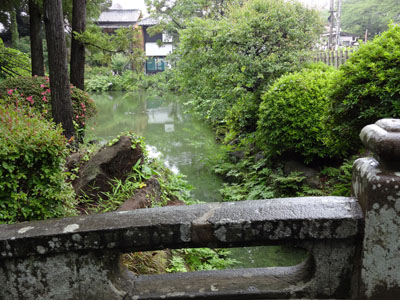 |
| We made a left and took a quick walk alongside a two-lane
paved road, following the signs to Jochiji Temple. We didn’t actually visit Jochiji Temple, instead we took the narrow road to the left of the temple, the start of the Daibutsu Hiking Course (ie. the trail to the Great Buddha). We passed a few homes nestled among the trees and then ascended into nature. As we gained altitude, we tried to peer through the dense trees for a view, but the foliage was too thick. There were no signs to guide us, but the path seemed fairly obvious. The fact that we saw a few Japanese people strolling along the trail in the opposite direction reassured us that we might be heading the right way. It was June rainy season in Japan and everything had a layer of dew on it. In some places, erosion had exposed serpentine tree roots. In others, the dirt trail had turned to slippery mud. |
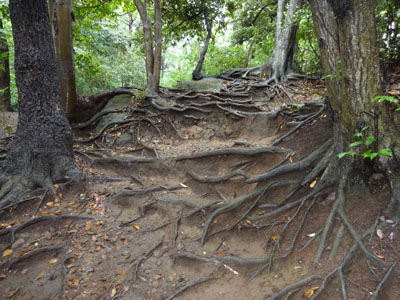 |
| After an hour or so, the trail opened up into a small park. In one corner, we discovered Kuzuharaoka Shrine, a love shrine with a miniature version of Meoto Iwa (the famous wedded rocks). |
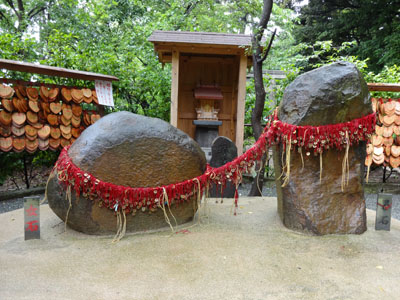 |
| There were many heart-shaped little wooden plaques (ema) on which people had written their wishes or prayers, rows of blossoming hydrangeas, and a small area where little ceramic plates could be purchased and then tossed against a rock to rid one of bad influences in life. There wasn’t much to the small shrine, but it was cute. As we were leaving, a monk emerged and quietly raked the rock path that led to the shrine. |
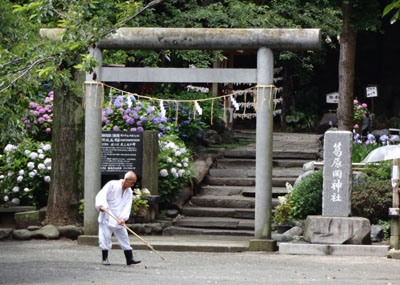 |
| Our next stop was Zeniarai-Benzaiten Shrine, a money-washing shrine near the Daibutsu Hiking Course. It is believed that washing one’s money at such a shrine and then spending it, causes luck for the spender. We asked a picnicking family for directions. They directed us down a steep road where we found the tunnel entrance to Zeniarai-Benzaiten Shrine. |
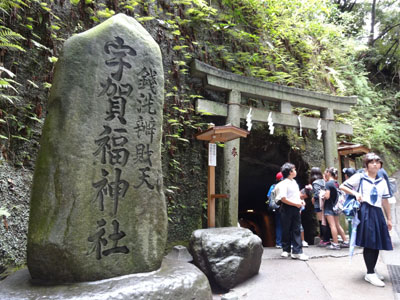 |
| The entrance reminded me of the tunnel that Chihiro and her family enter in Miyazaki‘s Studio Ghibli film, Spirited Away. At the other end of the tunnel, we found schoolchildren sitting on benches, enjoying their picnic lunches. We wandered little winding paths that led to small shrines until we found the cave where the money washing occurs. |
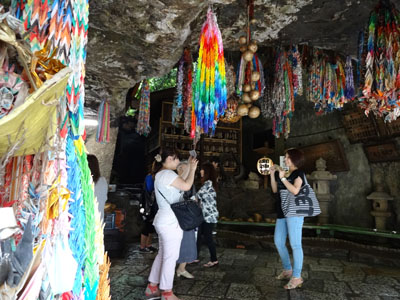 |
| Inside the cave, people were snapping photos of one another with their freshly-washed money. We watched the money-washing process to see how it was done: pick up a small basket, place money into the basket, pick up water from the stream with a ladle, and pour the water over the money. Since I was running low on cash (and I don’t think you’re supposed to wash credit cards) my friend offered me a 1,000 yen note to wash; hopefully his generosity brought him extra luck. |
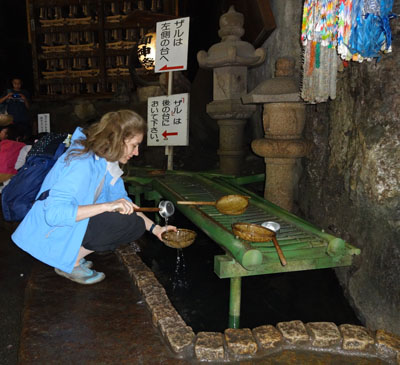 |
| We took turns washing our money. Then we posed for
obligatory me-with-my-freshly-washed-money photos. Near the
exit to the cave, I noticed a few lit candles along with a
sign that stated, in multiple languages including English,
“Dipped money dried [sic] naturally.” I can only assume that
people have tried to use the candles to dry their money,
with unfortunate, though predictable, consequences. We
slipped our wet money into our wallets for spending later. Back on the street just outside the shrine, two adorable Japanese girls, dressed in their school uniforms, shyly approached us. “Do you speak English?” one girl asked us. “Yes,” I said. “Can we ask you some questions?” the same girl asked. “Of course,” I said. “Where are you from?” the girl asked. “California,” I said. “Oooh,” both girls responded, delightedly. The first girl proceeded to carefully read a few questions from her school workbook, inquiring about our trip to Japan, and take down our responses. Apparently this is a common school project for children on field trips; we were questioned twice more by groups of school children during our two-week trip. After having enjoyed our side trip to the shrine, we rejoined the trail to the Great Buddha. The second part of the trail was more muddy and slippery than the first part. My shoes became less and less light-blue and more and more brown. Toward the end of the trail, we encountered a Japanese couple who were just starting their hike. The woman wore bright-white tennis shoes that were already showing signs of being enveloped by the mud. She smiled at me and pointed at her shoes sadly. I smiled and pointed at mine. The final few minutes of our hike were particularly precarious, requiring the holding of ropes, railings, and roots to keep us on our feet. We descended out of the woods on a skinny metal staircase that led to a paved road. Steps away, we found the entrance to the Kotokuin Temple, where the Great Buddha (AKA: Kamakura Daibutsu) is located. We paid the 200 yen entrance fee, rinsed the mud from our hands, and then we walked toward the towering Buddha. |
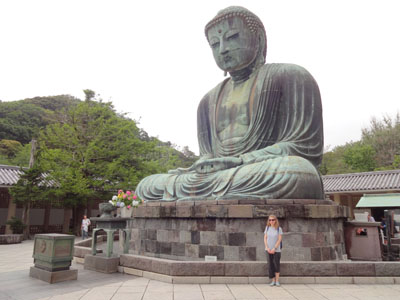 |
| From 8:00 AM to 4:30 PM, for just 20 yen each, visitors are
allowed to go inside the Buddha. We paid our yen and walked
up a little staircase into the belly of the Buddha. Inside,
there were coins along every ledge and in every nook and
cranny. Some people said a prayer. Some just admired the
engineering; there was a plaque that offered detailed
information in English and Japanese. I noticed that there
were windows built into the back of the Buddha that provided
some welcome ventilation on that warm June day. Back in the refreshing outdoors, I walked around the Buddha, admiring the statue from every angle, and wafted some of the smoke from the incense pot in front of it, over my body. |
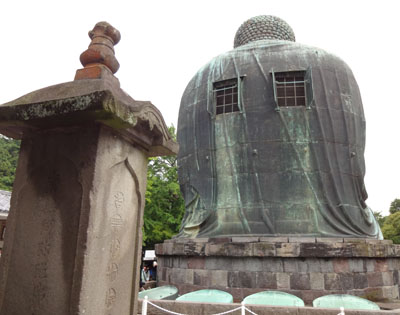 |
| Our final stop in Kamakura was Hase Temple (AKA: Hasedera). The temple was located a short walk away from the Great Buddha, along civilized sidewalks rather than muddy trails. When we arrived at the entrance, I opened my wallet and pulled out a damp 1,000 yen note to pay the 300 yen admission fee. Embarrassed, I sheepishly handed the wet money to the attendant. Unfortunately, my limited Japanese didn’t allow me to explain why my money was moist. The attendant didn’t seem bothered by it. I imagine that we weren’t the only ones who took Daibutsu Hiking Course to the Great Buddha with a side trip to the money-washing shrine before visiting Hase Temple. Maybe the attendant gets a lot of wet, lucky money, along with an explanation. At least I hope so. |
I did this in 2013 in Kamakura, Japan |
|
ABOUT THE AUTHOR Jen is also known as J.W. Lynne, a best selling author of eleven novels. Click on any of the titles below to see the book on Amazon! THE UNKNOWN: Eight kids learn the shocking reason why they were kidnapped. ABOVE THE SKY: A girl lives in a world where touching her soulmate is forbidden. THE DARKNESS OUTSIDE: A teen is locked in a bunker to take a simulated trip to the moon. KID DOCS: An experimental program turns kids into doctors. WILD ANIMAL SCHOOL: A girl falls in love with a boy at an exotic animal ranch. WHAT HE DIDN'T TELL ME: A traumatized girl meets a boy with a horrible secret. IF I TELL: A teen wonders if her father is a serial killer. Besides reading books and dreaming up stories to write, Jen's favorite activities are singing along to musical theater soundtracks and hiking in California's beautiful parks. **Jen's books are available on Kindle Unlimited.** |
 |
|
Find more reviews of Jen's adventures in Japan here. |
